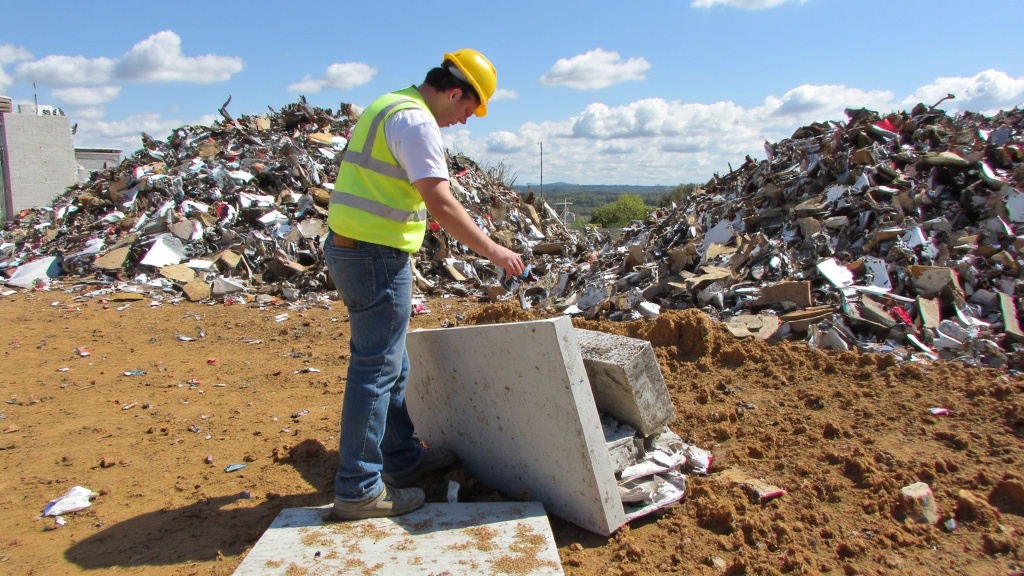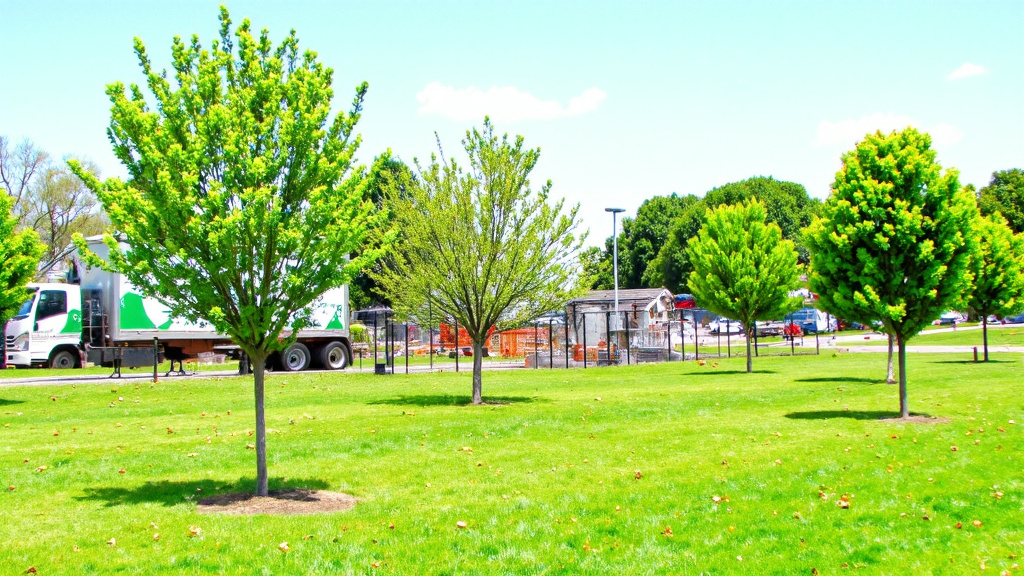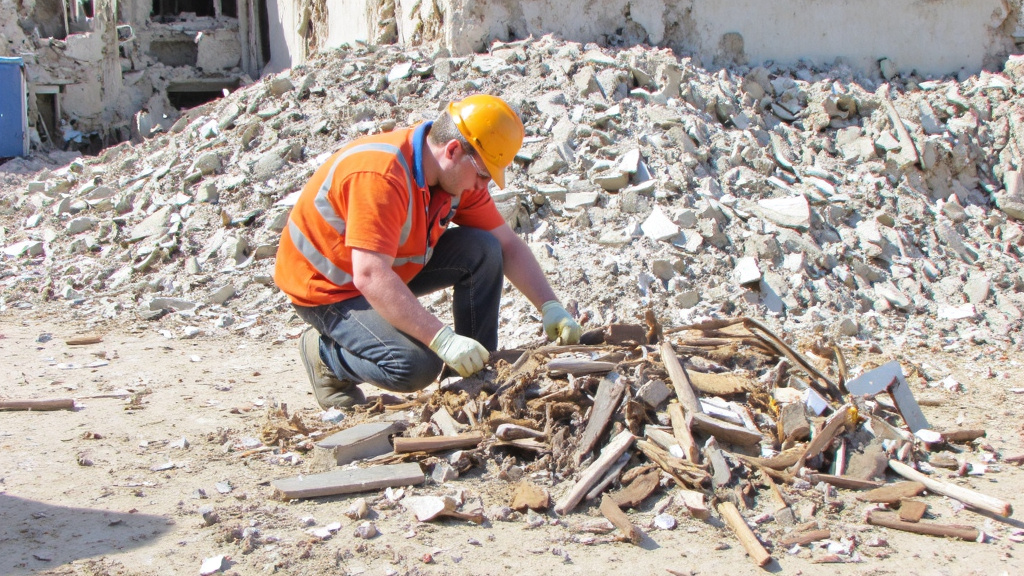5901 Botham Jean Blvd, Dallas, TX 75215
What Are Sustainable Demolition Practices?
May 4, 2025Demolition projects generate millions of tons of waste each year, much of which ends up in landfills, harming the environment and wasting valuable resources. Sustainable demolition offers a more effective approach.
Sustainable demolition practices involve carefully deconstructing buildings to maximize material recovery for reuse and recycling. This method contrasts with traditional demolition, which typically involves rapid teardown with minimal material salvage. The construction and demolition sector currently accounts for about 40% of global energy consumption and resource use.
Rather than viewing buildings as waste, sustainable demolition considers structures as repositories of valuable materials. Key practices include selective demolition (targeted removal of specific components), comprehensive material assessment before work begins, and methodical deconstruction processes that preserve material integrity. These techniques significantly reduce environmental impact while conserving natural resources.
What are the Key Components of Sustainable Demolition?
Selective Demolition
Selective demolition involves removing specific sections of a building while keeping the main structure intact. This method is ideal for renovation projects where complete demolition isn’t necessary.
Unlike traditional demolition that generates significant waste, selective demolition carefully separates building elements. This approach allows for precise recovery of valuable materials and reduces environmental impact.
The process typically requires specialized tools and techniques to minimize damage to surrounding structures. Teams identify salvageable components before work begins, creating a strategic plan for material recovery.
Comprehensive Material Assessments
Before demolition work starts, thorough material assessments are crucial for identifying salvageable items. These assessments catalog all potentially reusable materials in a building, from structural elements to fixtures.
Professional evaluations determine the functional and structural capacity of different components. This creates a material passport that guides the deconstruction team on disassembly processes and reuse opportunities.
Material assessments also identify hazardous substances requiring specialized handling. This prevents contamination of recyclable materials and ensures worker safety during the demolition process.
Deconstruction Techniques
Deconstruction involves carefully dismantling a structure piece by piece. Unlike traditional demolition, which focuses on rapid removal, deconstruction preserves material integrity for future use.
Modern deconstruction may use advanced technologies such as robotic systems for concrete cutting and precision dismantling of structural joints. These methods efficiently separate building components while maintaining their value.
Some projects use non-explosive chemical expansion agents to break down concrete structures. These agents are environmentally friendly alternatives to explosive demolition, producing no dust, gas, or pollution.
Waste Minimization Strategies
The construction and demolition industry generates about 30% of global solid waste. In the United States, this figure reaches up to 50%, with over 130 million tons of demolition waste produced annually.
Sustainable demolition prioritizes diverting materials from landfills through various strategies. Materials like concrete, brick, metal, wood, and glass are carefully separated for recycling or repurposing.
Some projects convert waste materials into energy through processes like gasification, transforming construction waste into usable fuel and further reducing environmental impact.
Economic Benefits
Contrary to common misconceptions, sustainable demolition often makes economic sense. While initial planning may require more time, the approach generates value by recovering saleable materials.
Projects can offset costs through reduced landfill tipping fees and potential revenue from salvaged materials. High-value items like copper wiring, quality lumber, and architectural features often find ready markets.
The Triton Square project by ARUP demonstrates these benefits. By retaining 88% of the substructure and reusing 3000m² of facade panels, the project reduced costs by 43% compared to traditional methods while saving 40,000 tonnes of carbon emissions.
How Does Sustainable Demolition Benefit the Environment?

Sustainable demolition practices offer substantial environmental benefits by reducing the industry’s ecological footprint. The construction and demolition sector accounts for about 40% of global energy consumption and resource use. By adopting sustainable methods, these impacts can be significantly mitigated.
A major environmental benefit is landfill diversion. Traditional demolition sends millions of tons of waste to landfills each year. Sustainable demolition reverses this by salvaging and repurposing materials, reducing pressure on overcrowded landfill sites and preventing harmful chemicals from leaching into soil and groundwater.
Resource Conservation and Reduced Demand for Raw Materials
Recycling materials like steel, concrete, and wood from demolition sites reduces the need for new resource extraction. This conservation has ripple benefits throughout the supply chain, decreasing mining operations, preserving forests, and minimizing habitat disruption.
Concrete can be crushed and reused as aggregate in new construction or as base material for roads. Steel and aluminum can be melted down and reformed with minimal quality loss, while wood can be repurposed as furniture, flooring, or biofuel. These practices preserve valuable resources for future generations.
Recycling one ton of steel saves 1.5 tons of iron ore, 0.5 tons of coal, and 40% of the water typically used in production. Reusing timber reduces the demand for new logging, protecting forest ecosystems that serve as crucial carbon sinks.
Carbon Footprint Reduction
Sustainable demolition significantly lowers carbon emissions through various mechanisms. It reduces the energy-intensive manufacturing of new materials, with cement production alone accounting for about 8% of global CO2 emissions. By reusing materials, this carbon-intensive process is bypassed.
Additionally, sustainable demolition reduces transportation emissions. Recycling materials on-site or locally means fewer trucks are needed to haul debris to distant landfills or bring new materials from manufacturing facilities, cutting fuel consumption and associated greenhouse gas emissions.
Landfills are major sources of methane, a greenhouse gas 25 times more potent than CO2. Diverting materials from landfills helps prevent these harmful emissions from entering the atmosphere.
Cleaner Air and Healthier Ecosystems
Beyond carbon reduction, sustainable demolition improves local environmental quality. Selective deconstruction techniques generate less dust and airborne particulates than traditional methods. Dust suppression measures further protect air quality in surrounding communities.
Water pollution prevention is another key benefit. Proper material handling prevents harmful chemicals from washing into local waterways during demolition. Erosion control measures like silt fences and sediment basins keep debris from contaminating stormwater systems.
These practices create healthier environments for wildlife and humans. Reduced dust means fewer respiratory issues for nearby residents, while cleaner waterways support aquatic ecosystems. Even noise pollution decreases when sustainable techniques replace traditional demolition methods.
The environmental case for sustainable demolition is compelling. By diverting waste from landfills, conserving natural resources, reducing carbon emissions, and minimizing pollution, these practices help build a more sustainable future for our planet.
| Benefit | Description |
|---|---|
| Landfill Diversion | Reduces pressure on overflowing landfill sites by salvaging and repurposing materials. |
| Resource Conservation | Recycling materials like steel, concrete, and wood reduces the need for virgin resource extraction. |
| Carbon Footprint Reduction | Lower emissions from reduced manufacturing of new materials and minimized transportation emissions. |
| Cleaner Air and Water | Less dust and fewer harmful chemicals prevent air and water pollution. |
| Biodiversity Protection | Preserves natural habitats and reduces disruption to local ecosystems. |
What Steps are Involved in Achieving Sustainable Demolition?

Sustainable demolition shifts from traditional practices, emphasizing careful planning, precise execution, and environmental responsibility. Here are the essential steps that enable sustainable demolition.
Conduct Pre-Demolition Assessments
Before physical work begins, thoroughly assess the structure. This identifies salvageable materials, potential hazards, and sets a project baseline.
A comprehensive assessment includes a material audit cataloging all recoverable resources. Teams identify valuable components like structural steel, copper wiring, and intact fixtures for repurposing.
This assessment also identifies hazardous materials such as asbestos, lead paint, or chemical contaminants that require specialized handling to prevent environmental contamination and ensure worker safety.
Develop a Comprehensive Waste Management Plan
A waste management plan serves as a roadmap for material handling throughout the project. It categorizes materials and outlines specific recovery, recycling, and disposal pathways.
The plan establishes sorting protocols for on-site material separation. Concrete, metals, wood, and other materials follow different recycling streams to maximize recovery and minimize landfill contributions.
Successful plans also include partnerships with local recycling facilities, ensuring materials have appropriate destinations and processing capabilities align with project needs.
Implement Selective Demolition Techniques
Unlike traditional demolition, selective demolition emphasizes careful deconstruction, preserving valuable materials.
Crews dismantle buildings systematically, removing reusable components first to protect them from damage and maintain their value.
Selective demolition requires specialized training and tools for precise material extraction. Though it may take longer, it significantly increases resource recovery rates.
Apply Dust Suppression Measures
Dust is a major environmental challenge in demolition projects. Effective management protects air quality, worker health, and surrounding communities.
Water-based suppression systems are the first line of defense against airborne particles, with regular spraying during active work preventing dust from becoming airborne.
Physical barriers like dust screens and containment systems further limit particle spread, especially near occupied buildings or sensitive environments.
Utilize Advanced Machinery and Technology
Modern demolition equipment offers significant advantages for sustainable practices. Energy-efficient machines with precise control reduce environmental impact and improve material recovery.
Specialized attachments like concrete pulverizers separate reinforcing steel from concrete on-site, streamlining recycling by pre-processing materials.
Some projects use robotic demolition units for hazardous areas, allowing precise work while keeping operators safe from contaminants.
Protect Local Ecosystems
Responsible demolition considers impacts beyond the immediate structure, protecting surrounding natural systems.
Projects must implement runoff control measures to prevent construction debris and contaminants from entering waterways. Silt fencing, retention basins, and filtration systems effectively manage stormwater.
Scheduling can also minimize wildlife disruption by avoiding demolition during breeding seasons or other sensitive periods for local species.
Monitor and Document Progress
Continuous evaluation ensures adherence to sustainability goals and compliance with environmental regulations.
Documentation of material recovery rates provides valuable metrics for project success. Teams track diverted materials by type and weight, creating a comprehensive record of environmental benefits.
These records serve multiple purposes, from regulatory compliance to sustainability certification requirements for programs like LEED, and help improve future demolition practices.
| Material Type | Diversion Rate (%) |
|---|---|
| Concrete | 70 |
| Wood | 57 |
| Metal | 95 |
| Brick | 80 |
| Asphalt | 85 |
| Glass | 50 |
| Plastics | 20 |
Engage with the Community
Sustainable demolition includes social responsibility, with community engagement creating transparency and support for activities.
Clear communication about project timelines, potential disruptions, and environmental safeguards helps address community concerns. Public information sessions provide dialogue opportunities with stakeholders.
Some projects involve community members through material donation programs, where salvaged materials support local building projects, creating positive social outcomes alongside environmental benefits.
By following these steps, demolition projects can reduce their environmental footprint while maximizing resource recovery, transforming a destructive process into an opportunity for conservation and protection.
What are the Economic and Social Benefits of Sustainable Demolition?

Sustainable demolition provides significant economic advantages. Companies can notably reduce disposal costs by diverting materials from landfills, leading to lower waste management fees when materials are recycled or reused.
Material recovery generates direct financial value. Salvaged items like timber, bricks, and metals can be resold or repurposed for new construction, creating additional revenue streams. Recycling steel alone can save up to 75% of the energy needed to produce new steel from raw materials, resulting in measurable cost savings.
Cost Efficiency and Long-Term Savings
The financial benefits of sustainable demolition extend beyond immediate savings. While green demolition techniques may initially appear more expensive due to the labor-intensive nature of careful deconstruction, long-term economics favor this approach. Reduced waste disposal expenses combined with potential tax incentives for recycling can offset initial costs.
These practices also align with increasingly strict environmental regulations, helping companies avoid potential fines and penalties. As sustainability becomes more important to clients and communities, companies practicing green demolition gain competitive advantages in the marketplace.
Social and Community Benefits
The social impact of sustainable demolition extends beyond cost considerations. By donating salvaged materials to local charities or nonprofit organizations, communities benefit from affordable building materials for housing projects or renovations. This fosters community engagement and builds positive relationships with local stakeholders.
Green demolition significantly improves public health and safety. Traditional demolition methods often release dust, debris, and hazardous materials into the environment. Sustainable practices prioritize controlled deconstruction and proper handling of materials, reducing exposure to harmful substances for workers and nearby residents.
Environmental Responsibility and Reputation
Companies that implement sustainable demolition practices demonstrate environmental responsibility, enhancing their public image and corporate reputation. This commitment to sustainability can strengthen relationships with environmentally conscious clients, partners, and communities.
These practices support broader green building initiatives and can help projects qualify for sustainability certifications such as LEED. Such certifications not only validate environmental commitments but can also increase property values and marketability.
| Aspect | Sustainable Demolition | Traditional Demolition |
|---|---|---|
| Material Recovery | High – Materials are salvaged and reused | Low – Most materials end up as waste |
| Waste Disposal Costs | Reduced – Less waste sent to landfills | Higher – More waste leads to higher disposal fees |
| Environmental Impact | Low – Reduces landfill waste and pollution | High – Contributes to landfill overflow and pollution |
| Economic Incentives | Available – Tax benefits and credits for sustainable practices | Limited – Fewer financial incentives |
| Job Creation | Higher – More labor-intensive, creating green jobs | Lower – Requires fewer workers |
Supporting Green Employment
The sustainable demolition sector creates specialized green jobs that contribute to local economies. The selective deconstruction process typically requires more workers than traditional demolition methods, generating employment opportunities in communities while developing skills in sustainable construction practices.
The demand for professionals trained in green demolition techniques continues to grow as more projects prioritize sustainability. This creates career pathways for workers to develop specialized expertise in environmentally responsible practices.
Advancing Circular Economy Goals
Sustainable demolition plays a critical role in advancing circular economy principles by keeping materials in use for longer periods. This approach reduces the demand for new raw materials and minimizes waste generation, creating a more sustainable economic model for the construction industry.
By prioritizing material recovery and reuse, sustainable demolition practices help close the loop in construction material lifecycles. This shift from a linear take-make-dispose model to a circular approach brings both economic and environmental advantages to communities and businesses alike.
Conclusion: Building a Smarter Future Through Sustainable Demolition
Sustainable demolition is not just an environmental initiative; it’s a smarter, more responsible way to approach the built environment. By prioritizing selective deconstruction, material recovery, and waste reduction, this approach transforms debris into valuable resources that fuel future construction. The environmental benefits—reduced emissions, conserved resources, cleaner air and water—are complemented by tangible economic gains and meaningful social impact.
From cost savings and job creation to improved public health and community engagement, sustainable demolition aligns environmental stewardship with long-term business value. It supports circular economy principles, helping the construction industry transition from a linear waste model to a regenerative, resource-efficient future.
As environmental regulations tighten and sustainability expectations rise, adopting sustainable demolition practices is not just a responsible choice; it’s a strategic advantage. By dismantling the past with intention, we can lay the foundation for a cleaner, greener, and more resilient tomorrow.
Ready to make your demolition project more sustainable? Contact Okon Recycling at 214-717-4083 to learn how we can help you recover valuable materials and reduce environmental impact.
